
Picture this: the world of Argentine artist Deborah Essés
28 September, 2010Some art, at least, seems designed – perhaps, not intentionally, to render thought and word redundant – a glaring, none-too-subtle full stop masquerading as something more profound. This is all well and good but it is like exploring the texture of a polystyrene ceiling tile looking for patterns. It’s akin to buying a train ticket and watching the train leave without you. Good art takes you somewhere – it has agency in time, space and the imagination.
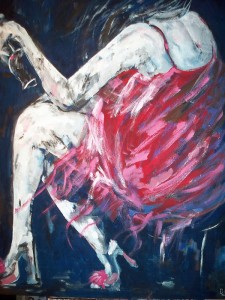
Argentine-born, Blackheath-based artist, Deborah Essés, who works in acrylic and mixed media, does just that. There’s something vital in her work; life-affirming and exploratory. It is a pleasure to gaze on form, line, colour, juxtaposition, texture, movement and the relationships between them and the spaces and planes that appear to inhabit two dimensions. In Essés’ case, to paraphrase Louis Armstrong on jazz, “Man, if you have to ask what art is, you’ll never know.”
Essés work has a narrative like a novel. It is there to be shaped in your mind’s eye. She provides an opportunity to engage with something more than her own ego. Her works are a whole not an atomized collection of parts randomly and arbitrarily thrown together or presented in isolation. As Essés herself says, “We have a saying in Spanish, ‘a button is enough as a sample’ (as when you buy clothes); if the button is good quality or not, properly attached, the appropriate colour, shape etc., detail can tell you so much about the whole and vice versa.”
There is a deliberate purposefulness, too, in the bold strokes, the vivid colour and the ever-present theme of grand and not so grand movement rendered in dramatic sweeps, rhythmical oscillations or the stop-start of staccato. In her works you are encouraged to join in and are not consigned to the passive role of an idolizing spectator. There is dialogue here because the imagery is redolent of so much.
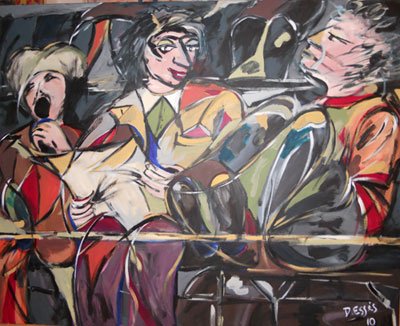
One composition, “Looking Back”, operates on so many levels. There is a melancholic desolation in the image. The railway tracks head towards the vanishing point seen from the position of an isolated female figure in a head scarf, or perhaps, through the smudged lens of a camera or an occluded eye. The subject matter, the tone, the landscape are all up for discussion and interpretation. They make us think and engage with the work and the world. There is an ambiguity, too, implicit in the physical, psychological and temporal elements of the work. It’s a moment in time – but what moment?
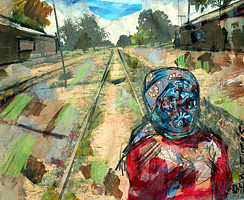 Essés studied for a BA at the Instituto de Bellas Artes “Beato Angelico”, Buenos Aires, art history in the Middle East at Tel Aviv University and mixed media under the tutelage of the Argentine artist/academic Professor Alfredo Portillos at the Escuela Superior de Bellas Artes “Ernesto de la Carcova”, Buenos Aires. Talking about the influence of Professor Portillo, she says “His work has nothing to do with mine but he used whatever he pleased to represent his idea and that’s what gave me the final push into ‘everything is allowed’ at the moment of deciding what media, what size, what colour… he passed that boldness on to me.”
Essés studied for a BA at the Instituto de Bellas Artes “Beato Angelico”, Buenos Aires, art history in the Middle East at Tel Aviv University and mixed media under the tutelage of the Argentine artist/academic Professor Alfredo Portillos at the Escuela Superior de Bellas Artes “Ernesto de la Carcova”, Buenos Aires. Talking about the influence of Professor Portillo, she says “His work has nothing to do with mine but he used whatever he pleased to represent his idea and that’s what gave me the final push into ‘everything is allowed’ at the moment of deciding what media, what size, what colour… he passed that boldness on to me.”
Argentina at the time was a country in which Hobson’s choice was the preferred electoral system. It either came with regulation gold braid or it didn’t come at all. This impacted on Essés, too. “I had my work destroyed once whilst a student because the principal of the university censored it. It was a photographic installation and I had to hand over my film. They were difficult times to exercise freedom publicly. But I do believe in crisis. I think if you can capitalize on it; it can make you grow up. It is the same with repression – it makes you fearful but at the same time it unleashes your thirst for freedom. Some of my tutors would facilitate an appropriate atmosphere for creativity, though, and that’s what I took with me wherever I went.”
Why does she focus on the figurative? “I like abstract art but I prefer figurative work because I don’t want to simplify my ideas. I like to express myself with as many ‘ingredients’ as I can. I also find the figurative image much more powerful than the abstract one.
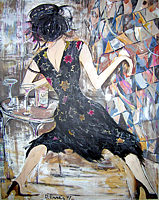 “I find abstraction more limited in terms of human psychology or human identification. I could never identify a square, a triangle, a shape, a paintbrush with that aunt I had who used to paint herself like a door – i.e. plaster herself in make-up. Completely unintentionally, I keep finding similarities between the people I’ve met and those depicted in my work. Abstraction would not have much do with my personality or with my background. Figurative representation, in my case, is formed by memories and impressions that I feel are unique to me.”
“I find abstraction more limited in terms of human psychology or human identification. I could never identify a square, a triangle, a shape, a paintbrush with that aunt I had who used to paint herself like a door – i.e. plaster herself in make-up. Completely unintentionally, I keep finding similarities between the people I’ve met and those depicted in my work. Abstraction would not have much do with my personality or with my background. Figurative representation, in my case, is formed by memories and impressions that I feel are unique to me.”
All artists draw from art and life and Essés claims the Italian futurist Carlo Carra plus Expressionist and post-war European painters (especially Austrian and German) such as Kokoshka, Dix, Munch, Kirchner and Beckman as some of her influences. She particularly likes the Futurists for their use of movement but all artists construct a dialectic between then and now, the common and the personal, the subjective and the objective. As she says, “You always paint what you see but even if you are copying something, you can’t avoid filtering the image through your own eyes and perception. I think being human means that you can never be 100% objective – everything goes through you first, even if you are using a machine – but what comes out is a synthesis.”
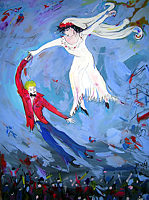 In some of Essés’ subjects you can see these influences at work. However, whether it is Marc Chagall or the Raymond Briggs’ “Snowman” – all human experience and art are paradoxical. They are of their time but always transcend it. The here and now can never be just that because it always encapsulates the past and always predicates the future. Speaking of which, Essés says, “It has never felt to me as a burden as I believe that artwork contains the history of humanity and the fact that Chagall, Matisse or Picasso produced what they did, is related to the times in which they lived. Whatever their influence on me, I’m living in a different time so I can only produce pieces that relate to that time. How do I separate myself from these ‘influences’? It’s like enriching what you learned at school with your own experiences.”
In some of Essés’ subjects you can see these influences at work. However, whether it is Marc Chagall or the Raymond Briggs’ “Snowman” – all human experience and art are paradoxical. They are of their time but always transcend it. The here and now can never be just that because it always encapsulates the past and always predicates the future. Speaking of which, Essés says, “It has never felt to me as a burden as I believe that artwork contains the history of humanity and the fact that Chagall, Matisse or Picasso produced what they did, is related to the times in which they lived. Whatever their influence on me, I’m living in a different time so I can only produce pieces that relate to that time. How do I separate myself from these ‘influences’? It’s like enriching what you learned at school with your own experiences.”
What guides her in her work? “I feel a constant need for a permanent ‘manicure’ of my thoughts. I also have an urge to speak out. What lies at the heart of it, I suppose, is a desire to be honest and express my own truth.”
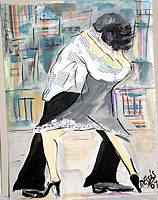 Essés work has been shown in Kent, where she’s worked on various adult and children’s art educational projects, her erstwhile home, Buenos Aires, as well as London venues such as the on-line Saatchi Gallery, Blackheath Art Society (2007-2010), Bow Gallery ( 2007), “Curzon Soho” Exhibitons Lounge (2008), The Crypt Gallery, Kings Cross (2009), Acquire Gallery, Battersea (2010). Between the 4-5th December and 11-12 December 2010, Essés will be holding an Open Studio at her on studio/gallery at 13 Halley Gardens, Lewisham, London SE13 5PA
Essés work has been shown in Kent, where she’s worked on various adult and children’s art educational projects, her erstwhile home, Buenos Aires, as well as London venues such as the on-line Saatchi Gallery, Blackheath Art Society (2007-2010), Bow Gallery ( 2007), “Curzon Soho” Exhibitons Lounge (2008), The Crypt Gallery, Kings Cross (2009), Acquire Gallery, Battersea (2010). Between the 4-5th December and 11-12 December 2010, Essés will be holding an Open Studio at her on studio/gallery at 13 Halley Gardens, Lewisham, London SE13 5PA
More info:
Official Page
Page at Saatchi Gallery
Facebook Page
Follow Sounds and Colours: Facebook / Twitter / Instagram / Mixcloud / Soundcloud / Bandcamp
Subscribe to the Sounds and Colours Newsletter for regular updates, news and competitions bringing the best of Latin American culture direct to your Inbox.

